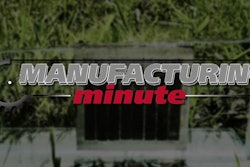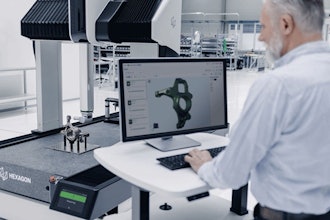Today the 'big' deal about IoT is scale. Technology today doesn’t just count the number of punches or laser cuts a machine does — IoT takes those and much more to a far larger scale. Sophisticated, IoT-enabled equipment today might have dozens, or even hundreds, of sensors continually monitoring the performance of equipment components such as lasers, cutters, grinders, accelerometers. Multiple sensors will also monitor operating conditions such as temperatures, humidity, weights, densities, flow and vibrations.
The volume of information gathered in real-time about equipment performance is higher than ever before. Much of this data can be dissimilar. IoT enables stream analytics — capturing a stream of data simultaneously from multiple data points and aggregating for analysis in real-time.
Machine Learning: A Step Further
Big data analytics also enables machine learning, allowing organizations to diagnose the potential for a machine malfunction based on analysis of the data it generates. For example, a sensor might detect that a punch in a numerically controlled machine is likely to breach tolerance levels. Stream analytics would then look for data points from other sensors that could suggest the cause of the out-of-tolerance condition. Such detailed, real-time analytics can enable true pre-emptive/predictive maintenance, empowering equipment operators and service organizations to take action long before a problem occurs.
These smart, connected assets can allow enterprises to move beyond real-time control to predictive control, and ultimately even autonomous operation.
Here are three examples from the utilities, manufacturing and transport industries of how IoT is empowering service providers to boost performance and results through predictive maintenance.
Utilities – Avoiding Catastrophes
Utility companies can leverage IoT and predictive maintenance to boost asset reliability and minimize reactive service costs. Electric utilities routinely gather information about their electricity generation and distribution network via SCADA (Supervisory Control and Data Acquisition) systems. Analysis of data gathered by these systems can proactively alert utility maintenance crews of a pending problem in a power substation, an individual transformer, or other parts of the distribution network. Natural gas utilities can leverage smart sensors to detect potential problems in compressors, corrosion and leaks in gas pipelines, or other pipeline components.
Data gathered by these remote sensors can be shared in real-time with pipeline operators.
Oil pipelines share many of the same issues as gas pipelines — information about failures or potential failures in the pipeline infrastructure must be immediately conveyed and remedied. IoT and predictive maintenance practices are crucial in helping utility companies avoid electricity outages, dangerous gas leaks, oil pipeline breaches, environmental catastrophes, and more.
Manufacturing – Good Vibrations
Manufacturing equipment often contains multiple mechanical components which must be aligned and calibrated properly. Such equipment has tolerances it must operate within to produce a high-quality end product. Sensors embedded in the manufacturing equipment can monitor the level of vibrations within the equipment and detect if vibration levels have, or are about to, extend beyond specified constraints.
Some manufacturing equipment must operate within certain temperature parameters as well. Sensors can monitor and track those temperature levels and immediately determine if operating temperatures are close to or outside of allowable parameters. These 'intelligent' devices can automatically and immediately alert operators about a new or impending service requirement and potential failure. Armed with that information in advance, the organization charged with maintaining the equipment can provide predictive service, based on the condition of the equipment, and rather than a static time schedule. Such predictive service circumvents future equipment downtime and the associated costs.
Transport – Opening Doors
IoT data enables fleet, long-haul trucking, railroad, and other transportation operators to anticipate vehicle service requirements. The data allows operators to proactively maintain those vehicles based on the equipment’s specific needs, rather than a number of miles or time interval since the last maintenance. A sensor-equipped vehicle exhibiting consistently high engine temperatures can be brought in for inspection and remedial maintenance, avoiding a costly breakdown. A tire pressure sensor on a delivery vehicle can automatically alert fleet maintenance staff that a tire may need to be repaired or replaced, thus sidestepping a potential delay in deliveries — or worse, an accident.
One European mass transit operator and IFS customer was experiencing frequent train door opening/closing problems in extreme cold weather. The doors would sometimes freeze shut or open, rendering that section of the rail car inoperable. The transit operator’s initial solution for this problem was to buy extra train cars, so if one car was inoperable due to a stuck door, they could quickly replace that car — not a very economical solution. To remedy this situation, the transit operator equipped its train cars with sensors that monitor how long it takes to open and close a door — if that time is within a specified operating tolerance, the door is OK.
Sensors in the door take readings every time the doors open or close. That information is passed to the IFS Applications platform, which simultaneously evaluates other data gathered from the IoT sensors — such as how long the train has been running, whether it is on time, whether it is raining or freezing outside, and more. Stream analytics measures all these and other data points and is able to accurately predict if a door is likely to fail within the next 500, 1,000 or other specified number of open/close operations. In other words, it 'predicts' possible failure, enabling maintenance before that failure.
A Problem Shared is a Problem Solved
In addition to monitoring the performance of individual pieces of equipment, smart devices and IoT can also be used to collect data from multiple pieces of equipment of the same type, creating large amounts of information that can be aggregated, analyzed and modeled. This accumulation of performance and reliability data enables comparisons of individual pieces of equipment with others of the same type or model. Comparative data can help service providers identify individual units that are operating outside the norm so corrective action can be taken proactively.
The accumulation of this data allows engineering, manufacturing, and service providers to identify product quality issues so they can be corrected in future versions of the product, or corrected for existing equipment through the creation of field upgrades and engineering changes. Underpinning this predictive maintenance strategy needs to be software that facilitates the analytics and modeling of all the data gathered from smart devices and IoT. The new generation of ERP software solutions are designed with agility and future technology in mind, making it possible for organizations to experience predictive maintenance and its efficiency — ultimately helping to harvest the benefit at the bottom line.
Smart Devices, Smart Solution, Smart Profit
The enterprise software supporting these smart devices and IoT make it possible for organizations to visualize and analyze equipment performance data in ways not previously possible.
Customers enjoy improved equipment performance, reliability, fewer outages, and longer equipment life. Service providers can implement predictive strategies for more efficient and cost-effective operations. They can plan optimized maintenance schedules in advance and significantly reduce reactive break/fix service events. Service technicians are more productive and can become the customer’s trusted advisor. Engineering and manufacturing can improve future product quality. At the top level, management will see greater operational productivity, reduced service costs, and stronger financial performance.
It’s a win win approach for service and asset-heavy organizations.
Patrick Zirnhelt is Vice President of Enterprise Service and Asset Management at IFS North America.























